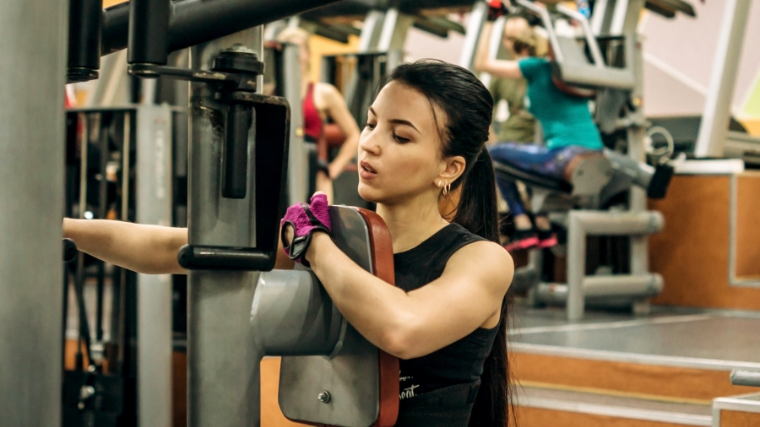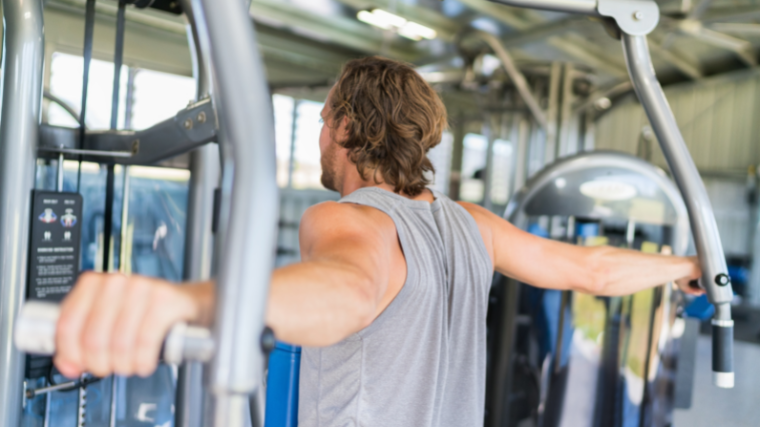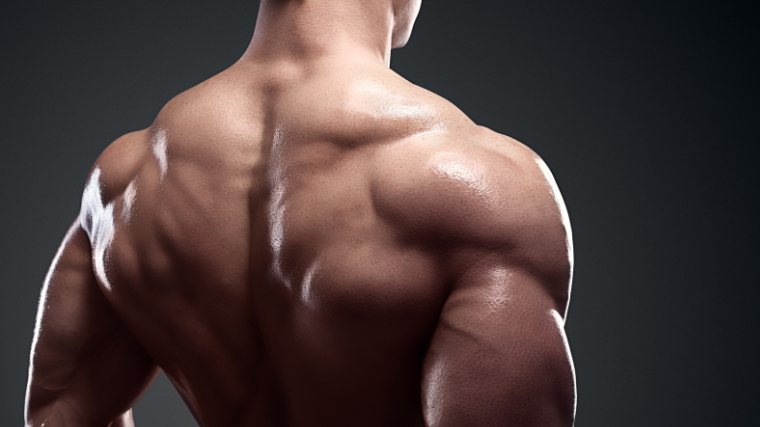No, they’re not using it wrong. If you’ve ever seen someone sitting backward on the pec deck machine at your gym, know that they aren’t practicing their breaststroke; they’re training the upper back and shoulders.
The reverse pec deck is one of the best exercises for developing, strengthening, and activating the musculature of your rear shoulder and upper back. It’s easy to use and customizable, and you can find the machine in most commercial gyms.

Whether you’re piling on the prehab work during a high-volume powerlifting program or chasing the pump on shoulder day, you need a rear delt movement that goes the distance. Here’s how to do the reverse pec deck (and a whole lot more).
- How to Do the Reverse Pec Deck
- Reverse Pec Deck Sets and Reps
- Common Reverse Pec Deck Mistakes
- Reverse Pec Deck Variations
- Reverse Pec Deck Alternatives
- Muscles Worked by the Reverse Pec Deck
- Benefits of the Reverse Pec Deck
- Who Should Do the Reverse Pec Deck
- Frequently Asked Questions
How to Do the Reverse Pec Deck
If you want to perform the reverse pec deck to beef up your upper back, you need access to a pec deck. While this station is similar to a machine chest flye, you’ll need a machine with adjustable arms to perform this exercise.
Step 1 — Adjust the Machine

First things first, you need to set up the machine to perform a reverse flye motion. To achieve this, pull on the adjustment pegs at the top of the station and rotate the arms until they’re parallel to each other.
Then, adjust the seat height as well. You should be sitting such that your arms are parallel to the floor when you grab the handles.
Coach’s Tip: Set the arms at the narrowest setting to guarantee you’re working through a full range of motion.
Step 2 — Sweep Your Arms

Once you’re set up, plug the weight peg into the stack at a relatively light resistance. Grab the handles of the machine — you can use a neutral, palms-facing grip, or go double overhand.
From there, initiate the movement by driving your arms out and to the sides until they’re in line with your body.
Coach’s Tip: Avoid pinching your shoulders back when you start the movement. Think instead about using your arms to “part the air.”
Reverse Pec Deck Sets and Reps
Like most machine-based movements, you can utilize the reverse pec deck for a variety of purposes. The lack of an external stability demand, or a complicated technique to learn, make the reverse pec deck highly versatile.
- For Shoulder Prehab: Try 2 sets of 15-20 reps with a light weight.
- For Muscle Growth: Go for 3 to 4 sets of 12 to 15 reps.
- As a Beginner: Start out with 1 or 2 sets of 10 reps.
Common Reverse Pec Deck Mistakes
Training your rear delts effectively is harder than it might seem. The reverse pec deck does put the movement on rails to some degree, but there are still a few technical considerations that you should be mindful of.
Lifting Too Heavy
The reverse pec deck is easy to overdo. Your rear deltoids are a small pair of muscles with limited tensile capacity; as such, it’s all too easy to let larger muscles like the traps or lats take over during the movement.
This is doubly true if you’re not used to the feeling of proper upper back activation. When you first implement the reverse pec deck, start out lighter than you think you need to and really focus on finding the connection with the muscle you’re trying to work.
Sitting Too Low
You don’t want to adjust the seat too low when you perform the reverse pec deck. Doing so causes the resistance curve to fall out of alignment with the target muscle. In simple terms, it means you won’t enable your rear deltoids to properly contract to move the weight.
Sit high enough that your arms are parallel to the floor while you perform the reverse pec deck.
Too Much Scapular Retraction
There are over a dozen different muscles that attach to or originate on your shoulder blades. As such, many upper back movements are easily hijacked by the larger, stronger muscles like the lats and traps. (1)
The reverse pec deck isn’t a scapular retraction movement, at least not primarily. Your rear deltoid draws the arm out away from the body. As such, when you perform the rear pec deck, avoid “pinching” your shoulders back until you’re near the end of the range of motion.
Reverse Pec Deck Variations
Unfortunately, there aren’t too many ways to tweak the reverse pec deck. It’s a machine-based exercise with a very specific movement pattern. However, you can make some small adjustments.
Single-Arm Reverse Pec Deck
Even though most people utilize the pec deck bilaterally, you can certainly use it to work one side of your body at a time.
The single-arm reverse pec deck is a great way to really hone in on activating your upper back. It should allow you to focus more intently on the muscular contraction, or give some extra love to a lagging shoulder.
Cable Rear Delt Flye
This isn’t strictly a variation of the machine pec deck, but it’s otherwise functionally identical. You can perform the exact same movement on a cable station if the machine is occupied.
Aside from providing consistent mechanical tension, the cables also afford you more freedom of movement. If you find the reverse pec deck machine a bit awkward, consider experimenting with cables instead.
Reverse Pec Deck Alternatives
If the machine is taken, unavailable, or you just don’t like it, don’t fret. There are plenty of other ways to train your upper back and rear delts just as well. Here are a couple of solid alternatives to the reverse pec deck.
Dumbbell Rear Delt Flye
You can also train your upper back and rear delts with a pair of dumbbells. To mirror the movement of a reverse pec deck, hop on a bench and perform the rear flye instead.
This movement is fantastic if the pec deck station is occupied. You can also move your arm freely while holding the dumbbell, ensuring that the resistance lines up just right with your personal structure.
Resistance Band Pull-Apart
Resistance bands aren’t just for warming up with (though they’re fantastic in that regard). You can grab a medium-to-heavy band and blast your rear delts with the pull-apart exercise.
Banded pull-aparts have a lot going for them. They’re easy to set up and perform quickly, there’s only a small learning curve, and the band itself provides accommodating resistance to your shoulder. The movement gets more difficult as the band is stretched, ensuring that your rear delts are taxed most when they’re at their weakest.
Face Pull
If you’re after some more comprehensive upper back engagement, grab a rope attachment and head to the cable trees to perform face pulls instead.
Face pulls are an all-in-one upper back developer. They’ll hit your rear delts if you externally rotate your arm while you pull, but also involve the larger trapezius muscles to a high degree as well.
Muscles Worked by the Reverse Pec Deck
As an isolation exercise, the reverse pec deck is mainly designed to stimulate your rear delts. However, there are a few other muscles worth touching on as well.
Rear Delts
Horizontal shoulder adduction — moving your arm outward from your midline — is the primary motor pattern at play during the reverse pec deck. That movement is largely controlled by the posterior component of the deltoid, or the back of your shoulder.
Research has also demonstrated that grip position can strongly impact how much of the tension is applied to your rear delt.

A neutral grip with your palms facing each other will externally rotate your scapula and should engage the rear delt to a higher degree than if you took a standard overhand grip. (2)
Middle Trapezius
Your rear delt is a very small muscle that often works synergistically with the other muscles in your upper back. As such, you’ll also find that the reverse pec deck hits your middle trapezius muscles as well, since the traps are well suited to retracting the shoulder blades.
Triceps
It’s by no means an arm exercise, but you’ll likely notice a small amount of triceps engagement as well during the reverse pec deck.
Although your triceps brachii is mainly an elbow extensor, the long head of the tissue also crosses the shoulder. When you move your arm with a straightened elbow, that head of the triceps will engage to some degree as a secondary mover.
Benefits of the Reverse Pec Deck
In addition to being easy to set up and perform, the reverse pec deck has a handful of other alluring benefits on offer.
Targeted Shoulder Training
Shoulder and chest pressing is great for building up your pecs and front delts, but most compound movements fail to properly stimulate the smaller muscles of the upper back.
Specifically, the horizontal adduction facilitated by the rear deltoid. The movement, and thus muscle, can be difficult to engage properly with free weights. The design of the reverse pec deck machine circumvents this problem and allows you to safely load up your rear delts.
It’s Failure-Friendly
One of the best parts of using exercise machines is the freedom they afford you to hit — and exceed — muscular failure. Taking your body to its limit is fantastic (in the proper contexts) for developing strength and size, but also comes with inherent risk.
However, there’s no danger of a weight spiraling out of control if you use the reverse pec deck. This makes it a great option for high-intensity upper back training.
Convenient to Perform
Similarly, exercise machines are built with ease of use in mind. If you wanted to perform a similar movement with free weights, you’d need both a pair of dumbbells as well as an adjustable bench; equipment that may not always be at your disposal in a busy gym.
But with the reverse pec deck machine, all you need to do is slot the pin into the appropriate peg and get to work.
Who Should Do the Reverse Pec Deck
Frankly, upper back training is a wise idea for just about every type of gymgoer. That said, the reverse pec deck is a fantastic option for a few types of lifter in particular.
Beginners
Beginner gymgoers should focus on building a well-rounded athletic foundation. Part of this entails training every muscle in your body to some degree, including and especially the little ones.
You don’t need three or four different rear delt exercises to get a proper workout; the reverse pec deck is an accessible plug-and-play option for newer trainees.
Strength Athletes
Strength sports contain a lot of pressing. Whether on a bench with a barbell, overhead on a weightlifting platform, or in one brutish motion with a log or axle bar. No matter your style, you should endeavor to train your upper back to augment both your performance and resilience.
Many strength athletes lean heavily on upper back movements like the reverse pec deck for shoulder prehab. It’s an easy, accessible, and convenient way to train your yoke without incurring extra fatigue that might interfere with your power output.
Bodybuilders
Physique development is all about hitting every nook and cranny of your body. Sometimes the muscles you can’t see need the most love. If you’re training for mass, you need an exercise like the reverse pec deck to guarantee you’re growing proportional, three-dimensional shoulders.
Build Bigger, Better Shoulders
Building a complete, well-rounded, healthy physique means training every single muscle in your body — including and especially the little ones.
Hitting the smaller tissues in your upper back is no easy feat, but the reverse pec deck makes rear delt training a breeze. What’s more, it’s easy to perform, convenient to set up, and you can find a station in just about every gym out there.
FAQs
Reverse pec deck got your brain working backwards? No big deal. Check out these common questions to see if you can put your fears to rest.
Which hand position is best for the reverse pec deck?
Research indicates that a neutral hand position with your palms facing each other will likely incur greater muscle activation of the posterior deltoid. However, if that grip is uncomfortable for you, your best bet is to stick with what’s sustainable.
How do I know if I’m lifting too heavy on the reverse pec deck?
The reverse pec deck is one of those movements that you can quickly and easily overload with too much weight. If you find yourself having trouble keeping your chest on the pad, or you’re bending your elbows to move the weight, you’re likely lifting too heavy.
References
1. Ehlers Botton, C., Wilhelm, E. N., Ughini, C. C., Pinto, R. S., & Lima, . C. S. (2013). Electromyographical analysis of the deltoid between different strength training exercises. Medicina sportiva / English edition, 17(2), pp. S. 67-71.
2. Schoenfeld, B., Sonmez, R. G., Kolber, M. J., Contreras, B., Harris, R., & Ozen, S. (2013). Effect of hand position on EMG activity of the posterior shoulder musculature during a horizontal abduction exercise. Journal of strength and conditioning research, 27(10), 2644–2649.
Featured Image: Maridav / Shutterstock